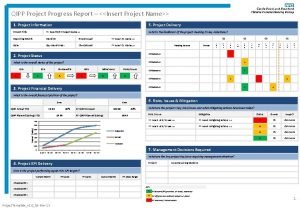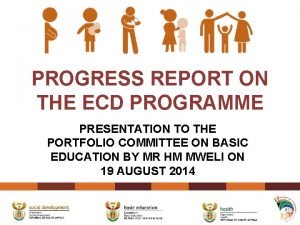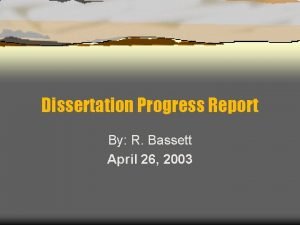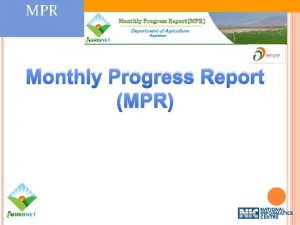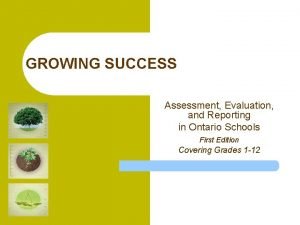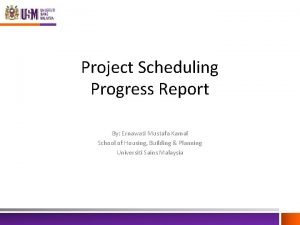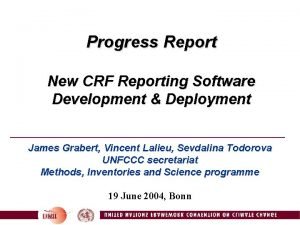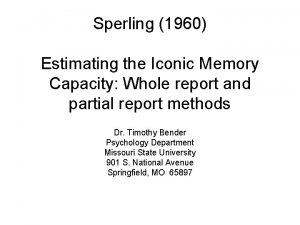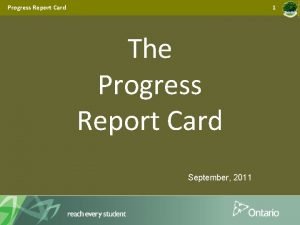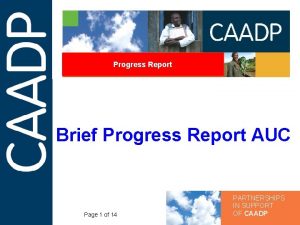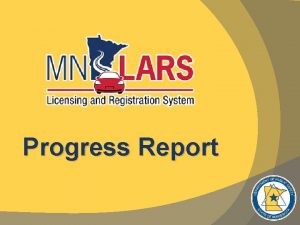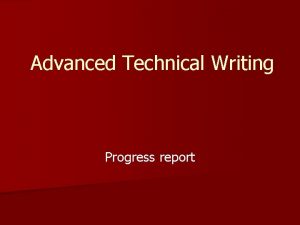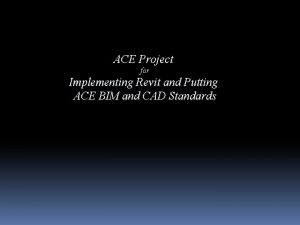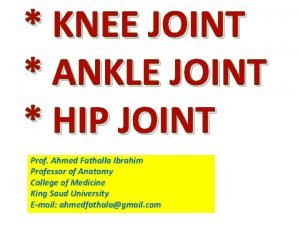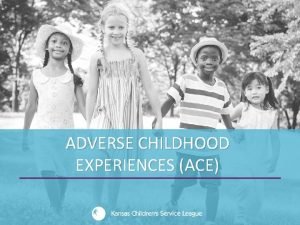ACE II Progress Report Joint ACE I and

























- Slides: 25

ACE II Progress Report Joint ACE I and ACE II Workshop Accra 7 -9 th November 2017 Eugene Mutimura, Ph. D ACE II Project Coordinator 7 th November 2017 Inter-University Council for East Africa (IUCEA), Regional Facilitating Unit (RFU)

ACE II Progress Report Outline 1. Background of ACE II 2. The IUCEA/ RFU Facilitation/Technical Support Activities § Component 1: Strengthening Africa Centers of Excellence (ACEs) in § Regional Priority Areas Component 2: Capacity Building Support to ACEs through Regional Interventions 3. Results Progress § Disbursement § Budget Execution

1. Background of ACE II Africa Development Challenges § Sub Saharan Africa is a land of youth, rich natural resources, and great opportunities and promises § Remarkable growth, last 15 years, still the world’s poorest region, faces challenges in maintaining sustainable and inclusive economic growth o. Higher Education Gross Enrollment ratio ~6 %; less than 30% major in science, health, ICT and engineering programs. o. Relatively Low research output- Global output § Commitment from African governments to transform the continent through “industrialization” and “regional integration”

Benefits of Centers of Excellence § Promote specialization and economy of scale § Promote mobility of students and faculty § Concentrate limited resources to develop best talent § Knowledge spill-over and networking nationally regionally and share best practice § Demonstration Effect: Pilot Higher education reform

Driver for Growth in Higher Education § Skills development Project • Give rise to higher productivity • Provide for complementary competitiveness § Access to knowledge /information • Application; problem-solving • Remaining relevant • Adapting to change § Generating new knowledge; research

What are Centers of Excellences- ACE II?

Forging a Network to Support Sustainable Development in Africa

Overall Goals of ACE II § Outreach and impact on society, gender and regional equity § Build institutional capacity: o To provide quality post graduate education of relevance to the job market relevancy o To conduct applied research of high quality, which is relevant to development challenges § Build/enhance partnerships with other academic institutions (national, regional and international) § Enhance partnerships with industry and private sector institutions § Teach through their benchmarked programs to help other institutions improve quality § Improve governance and management of the institution at all levels

Project Development Objective (PDO) of ACE II To strengthen selected Eastern and Southern African higher education institutions to deliver quality post-graduate education and build collaborative research capacity in the regional priority areas. Component 1 Component 2 Component 3 Strengthening Africa Centers of Excellence (ACEs) in Regional Priority Areas Capacity Building Support to ACEs through Regional Interventions Facilitation, Coordination, and Administration of Project Implementation (US$: 148. 0 Millions) (US$: 3. 0 Millions) (US$: 5. 0 Millions)

2. The IUCEA/ RFU Facilitation Activities Role of IUCEA/ RFU

• ACE II Project is coordinated & administered by IUCEA as the Regional Facilitation Unit; IUCEA was competitively selected § Implements Component 2 & 3 § Provides M&E support to ACEs § Builds capacity and facilitates knowledge-sharing § Supports partnership development and operations • Supported by a National Steering Committee (NSC), at each country level • At the regional level, guided by a Regional Steering Committee (RSC)

Technical Support Visits to ACEs • Since ACE II Project Launch Technical Support visits • Experts in specific subject disciplines • Often combine missions with World Bank

2. Facilitation Activities under Component 1 The ACE II Project officially launched on Oct 26, 2016, in Nairobi 7 out of 8 countries have been declared effective, along with IUCEA. Zambia has been retroactively declared effective 15 th Dec 2017, and the WB is awaiting National signatures IUCEA in the process of contracting independent verification firms for successive DLIs, anticipated to receive RFP 30 th Nov 2017 1 st Annual Work Plan along with budget for all ACEs have been developed, reviewed, and approved ACEs are developing new Ph. D. , Master, and short term courses, establishing partnerships with global leading higher education institutions as well as industries

Update on Effectiveness of ACE II Countries

ACE II Results – Regional Student Enrollment by Gender Indicator: Count of students enrolled in ACEs disaggregated by gender

ACE II Results – Total Student Enrollment by Gender Indicator: Count of students enrolled in ACEs disaggregated by gender

ACE II Results – Project Development Objective PDO Baseline 2017 MOUs on partnerships for collaboration 66 84 Accredited educational Programs offered by ACEs 59 58 779 1195 312 398 Direct Project beneficiaries (Total) Direct Project beneficiaries (Females)

ACE II Results – Intermediate Result (Component 1: Strengthening ACEs in Regional Priority Areas) Intermediate Results (Component one) Baseline § Faculty and Ph. D Student Exchange- Research & Teaching (Total) 64 § Faculty and Ph. D Student Exchange- Research & Teaching (Females) 16 § Amount of externally generated revenue by ACEs (million USD) 6. 1 2017 § Internationally recognized publications (Total) § Internationally recognized publications (Co-authored with regional collaborators) § No. of institutions hosting ACEs participating in the PASET benchmarking 194 308 15 122 0 7 138 19 12. 4

Facilitation Activities: Component 2 Goal: Capacity Building Support to ACEs through Regional Interventions: – Capacity development for ACEs partnership with private sector and industry – Competitive Masters Scholarships to academically deserving scholars

Support ACEs partnership Development with private sector/ industry 1. Private companies to be in the Centre governance advisory 2. 3. 4. 5. bodies of ACEs project activities Engage and form agreements with private sector and industry experts in actual Development of work-related activities to commercialize professional education, research and innovation Provide Innovative Research and Development Service Solutions Sharing of Technology and Equipment production Piloting "Customer-ordered Training Programs"

Support ACEs Partnerships with Private sector 6. Establishing Business Incubators and/or Learning Factories 7. Provide Internerships and Workplace Exposure Graduate Students 8. Provide Employment Opportunities to Graduate Students 9. Conduct Tracer Studies to know ACEs educational outcomes

Major recommendations from the 18 -19 Oct 2017 Kigali Meeting 1. Facilitate and support incubation and innovation centers 2. support business start-up projects for highly talented and innovative MSc graduates 3. Facilitate and support internship placements/ training in private industries 4. Conduct Initial Tracer Pilot studies (Universities will take it on) 5. Capacity building in IP and patent policy and process; leadership;

Develop and Implement (MSc) Scholarship programme to promote regional student mobility Goal: Provide competitive MSc Scholarships for top future talents, with the prestige Rhodes type of scholarship • TORs developed for the MSc Scholarship Program, approved by WB • The program had to take off together with ACEs Masters program

Disbursement and Budget Execution • • • The ACE II: Early stages of implementation 7 out of 8 countries declared effective, and funds disbursed Each ACE, for 22 ACEs (Except 2 ACEs from Zambia): USD 1. 1 Disbursement: 22 centers, plus IUCEA is ~US$ 25 million. Data not available for Budget Execution

Thank YOU!
 Difference between status report and progress report
Difference between status report and progress report Physical progress and financial progress
Physical progress and financial progress Qipp agenda
Qipp agenda Absorption of grade r practitioners 2022
Absorption of grade r practitioners 2022 How to make final year project presentation
How to make final year project presentation Dissertation progress report yale
Dissertation progress report yale Progress report memo format
Progress report memo format Mpr monthly progress report
Mpr monthly progress report Example of progress report in technical writing
Example of progress report in technical writing Progress report for internship
Progress report for internship Growing success progress report
Growing success progress report Tceq p2 annual progress report
Tceq p2 annual progress report Seo progress report
Seo progress report Progress report example
Progress report example Crf reporter
Crf reporter Joint
Joint Ellipsoid joint
Ellipsoid joint Lamb grading chart
Lamb grading chart Membrane tectoria
Membrane tectoria Joint venture account is a
Joint venture account is a Lamb carcass grading
Lamb carcass grading Progress and performance measurement and evaluation
Progress and performance measurement and evaluation Progress and performance measurement and evaluation
Progress and performance measurement and evaluation What is partial report technique
What is partial report technique Progress in leaps and bounds
Progress in leaps and bounds Quantum computing progress and prospects
Quantum computing progress and prospects


